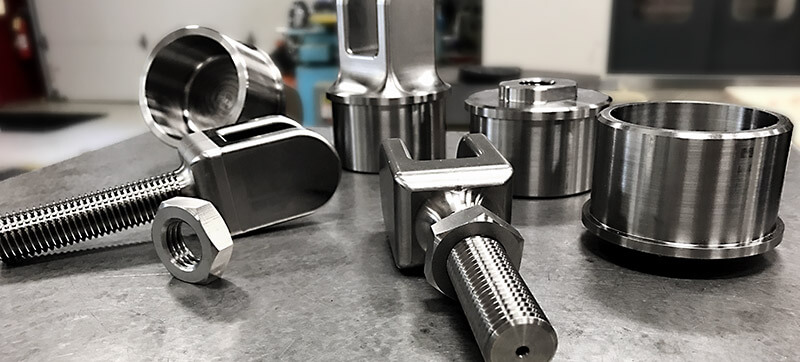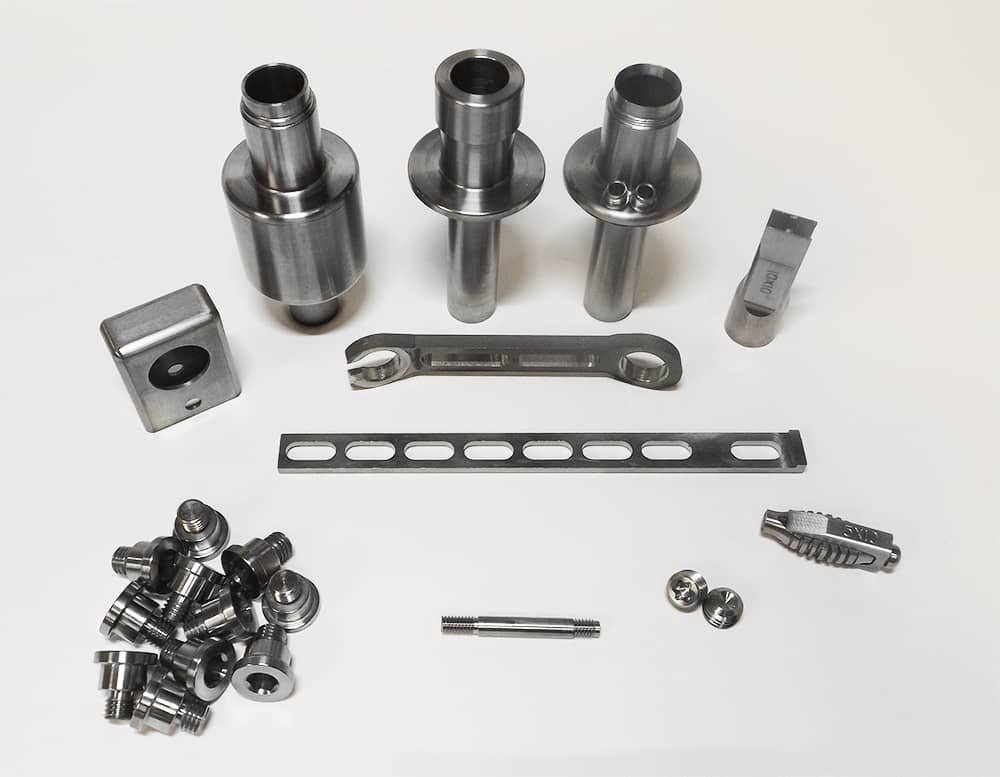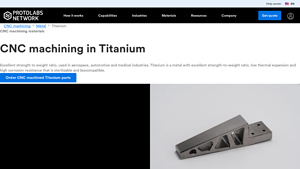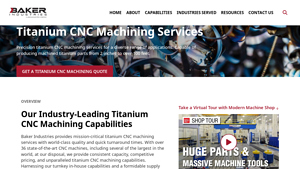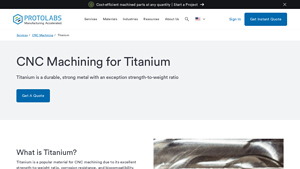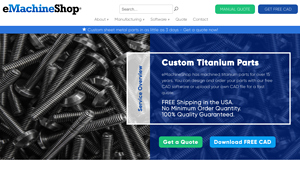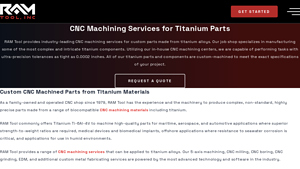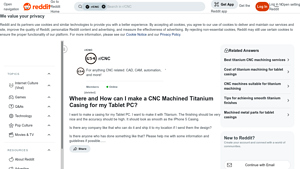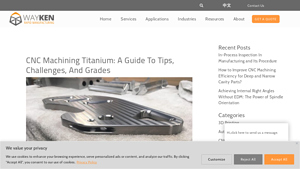Titanium Cnc Parts Guide: Type, Cost, Top List…
Introduction: Navigating the Global Market for titanium cnc parts
In today’s competitive landscape, sourcing titanium CNC parts presents a significant challenge for international B2B buyers, particularly those operating in dynamic markets across Africa, South America, the Middle East, and Europe. The unique properties of titanium, such as its exceptional strength-to-weight ratio and corrosion resistance, make it an ideal material for high-tech industries, including aerospace, automotive, and medical applications. However, navigating the complexities of sourcing quality titanium parts can be daunting, with concerns over supplier reliability, cost variations, and understanding the specific applications of different titanium grades.
This comprehensive guide aims to empower B2B buyers by providing in-depth insights into the diverse types of titanium CNC parts available, their applications across various industries, and critical factors to consider when vetting suppliers. We will delve into the nuances of material grades, machining processes, and surface finishes, ensuring that you are well-informed to make strategic purchasing decisions. Additionally, this guide will address cost considerations and lead times, helping you to anticipate and manage your procurement budgets effectively.
By leveraging the insights and actionable advice in this guide, international buyers can confidently navigate the global market for titanium CNC parts, ensuring they select the right components that meet their operational needs while optimizing value and quality.
Understanding titanium cnc parts Types and Variations
| Type Name | Key Distinguishing Features | Primary B2B Applications | Brief Pros & Cons for Buyers |
|---|---|---|---|
| Titanium Grade 1 | Commercially pure, excellent corrosion resistance, high ductility | Medical devices, marine applications | Pros: High biocompatibility; good for sensitive applications. Cons: Lower strength compared to higher grades. |
| Titanium Grade 5 | Alpha-beta alloy, high strength-to-weight ratio, corrosion-resistant | Aerospace, automotive, medical | Pros: Versatile and durable; suitable for high-performance applications. Cons: More expensive than lower grades. |
| Titanium Grade 2 | Superior corrosion resistance, good weldability | Chemical processing, architecture | Pros: Excellent formability; reliable in various environments. Cons: Weaker than Grade 5, limiting heavy-load applications. |
| Titanium Grade 9 | Improved strength and corrosion resistance | Aerospace, automotive, consumer products | Pros: Good for elevated temperature applications; reliable. Cons: More complex machining requirements. |
| Titanium Grade 23 | High-strength, excellent fatigue resistance | Aerospace, medical devices | Pros: Superior performance in critical applications; good durability. Cons: Higher cost and specialized sourcing may be necessary. |
What are the characteristics and suitability of Titanium Grade 1 CNC Parts?
Titanium Grade 1 is known for its commercially pure form, offering excellent corrosion resistance and high ductility. This grade is particularly suitable for applications requiring biocompatibility, such as medical devices and marine components. When purchasing Grade 1 parts, buyers should consider the trade-off between strength and corrosion resistance, as this grade is less robust compared to others. Its lower cost and ease of machining make it an attractive option for less demanding applications.
How does Titanium Grade 5 stand out among CNC Machined Parts?
Titanium Grade 5, or Ti-6Al-4V, is an alpha-beta alloy recognized for its exceptional strength-to-weight ratio and corrosion resistance. It is widely used in aerospace, automotive, and medical applications where performance is critical. Buyers should note that while Grade 5 parts are more expensive, their durability and versatility justify the investment, especially in high-stress environments. The machining of Grade 5 requires advanced techniques, making it essential to partner with experienced manufacturers.
What advantages does Titanium Grade 2 offer for industrial applications?
Titanium Grade 2 is favored for its superior corrosion resistance and good weldability, making it suitable for diverse applications, including chemical processing and architecture. Its excellent formability allows for the production of complex shapes, which is a significant advantage for custom parts. However, buyers should be aware of its lower strength compared to higher-grade titanium, which may limit its use in heavy-load applications. Cost considerations are also important, as Grade 2 offers a balance between performance and affordability.
Why choose Titanium Grade 9 for demanding environments?
Titanium Grade 9 is characterized by its improved strength and corrosion resistance, making it ideal for applications in aerospace and automotive industries. This grade performs well in elevated temperature conditions, which is essential for components exposed to high heat. When sourcing Grade 9 parts, buyers should consider the complexity of the machining process, as it may require specialized equipment and expertise. The investment in Grade 9 is justified by its reliability and performance in critical applications.
What makes Titanium Grade 23 a preferred choice for high-performance needs?
Titanium Grade 23, known for its high strength and excellent fatigue resistance, is particularly suited for aerospace and medical device applications. Its superior performance in critical environments makes it a preferred choice among manufacturers. However, the cost of Grade 23 can be higher, and sourcing may involve specialized suppliers. Buyers should weigh the benefits of enhanced durability and performance against the potential for increased expenses, especially for large-scale production runs.
Key Industrial Applications of titanium cnc parts
| Industry/Sector | Specific Application of titanium cnc parts | Value/Benefit for the Business | Key Sourcing Considerations for this Application |
|---|---|---|---|
| Aerospace & Defense | Aircraft components and structural parts | High strength-to-weight ratio enhances fuel efficiency and performance. | Compliance with stringent aerospace standards and certifications. |
| Medical Devices | Surgical instruments and implants | Biocompatibility ensures safety and longevity in the human body. | Need for precise tolerances and sterilization capabilities. |
| Automotive | Engine components and lightweight structures | Reduces overall vehicle weight, improving fuel efficiency and performance. | Consideration of material grades for specific automotive applications. |
| Oil & Gas | Equipment for extreme environments | Corrosion resistance prolongs equipment life in harsh conditions. | Sourcing from suppliers with experience in high-pressure applications. |
| Energy & Power Generation | Turbine parts and heat exchangers | Enhances operational efficiency and durability under high temperatures. | Need for reliable supply chains and rapid prototyping capabilities. |
How Are Titanium CNC Parts Used in Aerospace & Defense?
In the aerospace and defense industry, titanium CNC parts are critical for manufacturing aircraft components such as structural frames and engine parts. The impressive strength-to-weight ratio of titanium allows for significant weight reduction, which translates into improved fuel efficiency and enhanced performance. International buyers must ensure that their suppliers comply with strict aerospace standards and certifications, as any failure in quality can lead to catastrophic results.
What Role Do Titanium CNC Parts Play in Medical Devices?
Titanium CNC parts are extensively used in the production of surgical instruments and implants due to their biocompatibility and corrosion resistance. These properties make titanium ideal for applications requiring long-term exposure to bodily fluids without degradation. Buyers in the medical sector should prioritize suppliers who can meet precise tolerances and offer sterilization capabilities, ensuring that products are safe for use in medical environments.
How Are Titanium CNC Parts Beneficial in the Automotive Industry?
In automotive manufacturing, titanium CNC parts are employed in engine components and lightweight structures, facilitating weight reduction without compromising strength. This is particularly important in the context of rising fuel efficiency standards and performance demands. Buyers should consider the specific material grades suitable for automotive applications, as different grades offer varying levels of strength and corrosion resistance.
Why Are Titanium CNC Parts Essential for Oil & Gas Applications?
The oil and gas industry relies on titanium CNC parts for equipment designed to withstand extreme environments, including high pressure and corrosive substances. Titanium’s superior corrosion resistance ensures that components have a longer lifespan, reducing maintenance costs and downtime. Buyers should seek suppliers with proven experience in high-pressure applications to ensure the reliability and safety of their equipment.
How Do Titanium CNC Parts Enhance Energy & Power Generation?
In the energy sector, titanium CNC parts are used in the manufacturing of turbine components and heat exchangers, where durability and efficiency are paramount. Titanium’s ability to withstand high temperatures without deforming makes it an excellent choice for these applications. When sourcing titanium parts, businesses need to ensure they have access to reliable supply chains and rapid prototyping capabilities to meet the demands of an ever-evolving energy landscape.
3 Common User Pain Points for ‘titanium cnc parts’ & Their Solutions
Scenario 1: Navigating Complex Specifications for Aerospace Applications
The Problem: In the aerospace industry, precision and compliance with strict regulations are paramount. B2B buyers often face difficulties in accurately specifying titanium CNC parts that meet both their design requirements and industry standards. This challenge can lead to costly delays in production and compliance issues if the wrong materials or specifications are chosen, ultimately affecting project timelines and budgets.
The Solution: To overcome these hurdles, buyers should engage in a collaborative approach with their CNC machining service providers early in the design phase. It’s crucial to provide detailed CAD drawings and specifications that outline the intended use and performance requirements. Additionally, consulting with engineers who specialize in titanium machining can help identify the appropriate titanium grade (such as Grade 5 for aerospace applications) that balances strength, weight, and corrosion resistance. Establishing a strong partnership with suppliers who have a proven track record in aerospace projects will also ensure adherence to the required certifications and standards, thus mitigating risks associated with non-compliance.
Scenario 2: Managing Costs and Lead Times in Competitive Markets
The Problem: B2B buyers often grapple with the dual pressures of maintaining competitive pricing while ensuring quick turnaround times for titanium CNC parts. Fluctuating material costs and extended lead times can significantly affect project budgets and delivery schedules, making it challenging for businesses to meet client expectations and remain profitable.
The Solution: To effectively manage these challenges, buyers should consider implementing a strategic sourcing strategy that includes multiple suppliers. By evaluating and partnering with various CNC machining service providers, buyers can compare pricing structures and lead times. Additionally, leveraging technology such as online quoting tools can streamline the procurement process, allowing for quicker decision-making. It’s also beneficial to communicate clearly with suppliers about project timelines and budget constraints upfront. This transparency can encourage suppliers to offer flexible solutions, such as bulk ordering discounts or expedited processing options, helping to keep costs manageable while ensuring timely delivery.
Scenario 3: Ensuring Quality and Consistency in Custom Machined Parts
The Problem: Many B2B buyers experience frustration with inconsistent quality in titanium CNC parts, especially when dealing with custom orders. Variability in machining processes or material quality can lead to defects, requiring rework or replacements that increase costs and delay projects. This inconsistency can be particularly damaging in industries where reliability and safety are critical, such as medical or automotive applications.
The Solution: To address quality concerns, buyers should prioritize working with suppliers who have robust quality control processes in place. Requesting detailed documentation of the supplier’s quality assurance protocols, including certifications and inspection reports, can provide reassurance regarding their commitment to quality. Implementing a thorough pre-production sample approval process can also help identify potential issues before full-scale manufacturing begins. Additionally, fostering a culture of open communication with suppliers can lead to continuous improvement initiatives, where feedback is used to refine processes and enhance the quality of the titanium CNC parts. Regular audits and reviews of supplier performance can further ensure that quality standards are consistently met, reinforcing reliability in the supply chain.
Strategic Material Selection Guide for titanium cnc parts
What Are the Key Properties of Common Titanium Materials for CNC Parts?
When selecting materials for titanium CNC parts, it’s crucial to understand the properties and performance characteristics of different titanium grades. The most commonly used grades include Titanium Grade 1, Grade 2, and Grade 5, each offering unique benefits and limitations that can significantly impact their suitability for various applications.
Titanium Grade 1: The Purest Form for Corrosion Resistance
Titanium Grade 1 is known for its exceptional corrosion resistance and high ductility. With a low strength-to-weight ratio, it is ideal for applications where weight is a critical factor, such as in the aerospace and medical industries. This grade can withstand temperatures up to 600°F (316°C) and is suitable for environments with exposure to chlorides.
Pros: Its excellent corrosion resistance and formability make it suitable for intricate designs and applications in harsh environments.
Cons: However, its lower strength compared to other grades may limit its use in high-stress applications, making it less suitable for structural components.
Impact on Application: Ideal for marine and medical applications, Grade 1 is compatible with saline environments and sterilization processes.
Considerations for International Buyers: Buyers should ensure compliance with ASTM B265 standards and consider specific regional regulations regarding medical devices or marine applications.
Titanium Grade 2: A Balance of Strength and Ductility
Titanium Grade 2 is often regarded as the workhorse of titanium materials. It offers a balance between strength and corrosion resistance, making it versatile for a variety of applications, including aerospace and automotive sectors. Its temperature rating is similar to Grade 1, but it provides improved strength.
Pros: The enhanced strength allows for more robust applications, while its excellent weldability makes it suitable for complex assemblies.
Cons: The cost can be higher than Grade 1 due to its superior properties, and it may require more complex machining processes.
Impact on Application: Grade 2 is suitable for chemical processing and marine applications, where both strength and corrosion resistance are necessary.
Considerations for International Buyers: Compliance with ASTM B338 standards is essential, especially for industries like aerospace and chemical processing, which may have stringent requirements.
Titanium Grade 5: The High-Performance Alloy
Titanium Grade 5, also known as Ti-6Al-4V, is an alpha-beta alloy that combines high strength with excellent corrosion resistance. It is widely used in aerospace, military, and high-performance automotive applications. This grade can withstand temperatures up to 800°F (427°C).
Pros: Its superior strength-to-weight ratio makes it ideal for critical components that require durability without adding excessive weight.
Cons: The increased strength comes with a higher cost and more complex machining requirements, which can lead to longer lead times.
Impact on Application: Grade 5 is suitable for high-stress environments, such as aerospace components and medical implants, where both strength and biocompatibility are paramount.
Considerations for International Buyers: Buyers should ensure compliance with ASTM F136 for medical applications and be aware of the specific standards required in their regions, such as DIN or JIS.
Summary Table of Titanium Materials for CNC Parts
| Material | Typical Use Case for titanium cnc parts | Key Advantage | Key Disadvantage/Limitation | Relative Cost (Low/Med/High) |
|---|---|---|---|---|
| Titanium Grade 1 | Marine applications, medical devices | Exceptional corrosion resistance | Lower strength limits structural uses | Medium |
| Titanium Grade 2 | Aerospace, chemical processing | Balanced strength and corrosion resistance | Higher cost and complexity in machining | Medium |
| Titanium Grade 5 | Aerospace components, medical implants | High strength-to-weight ratio | Higher cost and longer lead times | High |
This strategic material selection guide provides B2B buyers with critical insights into the properties, advantages, and limitations of various titanium grades, aiding in informed decision-making for their specific applications.
In-depth Look: Manufacturing Processes and Quality Assurance for titanium cnc parts
What Are the Key Manufacturing Processes for Titanium CNC Parts?
The manufacturing process for titanium CNC parts involves several critical stages, each designed to ensure precision, quality, and adherence to specifications. Understanding these stages can help B2B buyers make informed decisions when sourcing titanium components.
1. Material Preparation: How Is Titanium Processed Before Machining?
The first step in manufacturing titanium CNC parts is material preparation. Titanium is typically supplied in the form of bars, sheets, or blocks, depending on the required dimensions. This material must undergo thorough inspection to assess its physical properties and to confirm that it meets the specified material grade, such as Grade 1, Grade 2, or Grade 5.
Once verified, the titanium is cut to the required size using saws or waterjet cutting technology. This step is crucial as it reduces waste and ensures that the subsequent machining process is efficient. Material preparation also involves cleaning the titanium to remove any contaminants that could affect machining or surface quality.
2. What Techniques Are Used in Forming Titanium Parts?
After material preparation, the next stage is forming the titanium parts through CNC machining. This process can include:
-
CNC Milling: Utilizing 3-axis or 5-axis milling machines, titanium is shaped into the desired form. The choice of milling technique depends on the complexity of the part and the required tolerances.
-
CNC Turning: This technique is applied to create cylindrical parts. The titanium workpiece is rotated while a cutting tool shapes it into the desired geometry.
-
CNC Drilling and Tapping: These processes are used to create holes and threads in the titanium components, essential for assembly and functionality.
The precision of these techniques is vital, as titanium’s hardness can lead to increased tool wear. Manufacturers often use specialized tools and cutting fluids to enhance the machining process and prolong tool life.
3. How Is Assembly Conducted for Titanium CNC Parts?
For components that consist of multiple parts, assembly is the next crucial stage. This may involve welding, fastening, or adhesive bonding, depending on the application and design requirements. Given titanium’s unique properties, such as biocompatibility and corrosion resistance, careful attention must be paid to the joining methods used to ensure structural integrity.
Quality assurance during the assembly phase is critical, as any defects can compromise the performance of the final product. Manufacturers often utilize jigs and fixtures to maintain accuracy during assembly.
4. What Finishing Techniques Enhance the Quality of Titanium Parts?
Finishing processes are employed to enhance the surface quality and performance characteristics of titanium parts. Common finishing techniques include:
-
Bead Blasting: This method is used to create a uniform surface texture, improving aesthetics and reducing friction.
-
Polishing: A finer finish can be achieved through polishing, which is often required for medical and aerospace applications where surface roughness can affect performance.
-
Coatings: Various coatings can be applied to enhance corrosion resistance or wear properties. Options include anodizing and powder coating.
These finishing techniques not only improve the appearance but also increase the longevity and functionality of the titanium parts.
What Quality Assurance Standards Should B2B Buyers Expect?
Quality assurance (QA) is a crucial element in the manufacturing of titanium CNC parts, ensuring that the final products meet specified standards and requirements. Buyers should be aware of both international and industry-specific standards when evaluating potential suppliers.
1. What Are the Relevant International Standards for Titanium Parts?
ISO 9001 is a widely recognized international standard for quality management systems. Companies adhering to ISO 9001 demonstrate a commitment to consistent quality and customer satisfaction, making it a vital certification for B2B buyers to look for when sourcing titanium parts.
Additionally, industry-specific certifications may include:
-
CE Marking: Essential for products sold in the European Economic Area, indicating compliance with health, safety, and environmental protection standards.
-
API Certification: Relevant for suppliers serving the oil and gas industry, ensuring products meet strict quality and safety standards.
2. What Are the Key Quality Control Checkpoints in Manufacturing?
Quality control (QC) checkpoints are critical throughout the manufacturing process. Common QC checkpoints include:
-
Incoming Quality Control (IQC): This initial checkpoint involves inspecting incoming materials for compliance with specifications before they enter production.
-
In-Process Quality Control (IPQC): During machining, regular checks are performed to ensure that the manufacturing process remains within specified tolerances.
-
Final Quality Control (FQC): Once the parts are completed, a final inspection is conducted to verify that they meet all specifications and standards before shipment.
B2B buyers should inquire about a supplier’s QC processes to ensure thorough inspections are in place.
3. What Testing Methods Are Commonly Used for Titanium Parts?
Testing methods for titanium CNC parts may include:
-
Non-Destructive Testing (NDT): Techniques such as ultrasonic testing, dye penetrant testing, and X-ray inspection are employed to detect internal and surface defects without damaging the parts.
-
Mechanical Testing: Tensile tests, hardness tests, and fatigue tests are conducted to assess the mechanical properties of the titanium parts, ensuring they meet performance requirements.
-
Chemical Analysis: This is performed to verify the material composition, ensuring that the titanium meets the required grade specifications.
How Can B2B Buyers Verify Supplier Quality Control?
For international B2B buyers, particularly those from Africa, South America, the Middle East, and Europe, verifying a supplier’s quality control measures is crucial for ensuring product quality.
1. What Steps Can Buyers Take to Assess Supplier Quality?
-
Supplier Audits: Conducting on-site audits allows buyers to assess the manufacturing processes, quality control systems, and overall operational capabilities of the supplier.
-
Requesting Quality Reports: Buyers should request detailed quality assurance reports, including results from testing and inspection processes.
-
Third-Party Inspections: Engaging third-party inspection services can provide an unbiased evaluation of the supplier’s quality control measures and product quality.
2. Are There Specific QC and Certification Nuances for International Buyers?
International buyers must also be aware of potential nuances in QC and certification requirements across different regions. For instance, certain certifications may be more recognized in specific markets, influencing supplier selection. Additionally, understanding the import regulations and quality expectations in target markets can help buyers navigate potential compliance issues.
By comprehensively understanding the manufacturing processes and quality assurance standards for titanium CNC parts, B2B buyers can make informed decisions that align with their operational needs and quality expectations. This diligence not only mitigates risks but also enhances long-term supplier relationships.
Practical Sourcing Guide: A Step-by-Step Checklist for ‘titanium cnc parts’
Introduction
This practical sourcing guide is designed for B2B buyers looking to procure titanium CNC parts. It provides a step-by-step checklist to ensure that your procurement process is efficient, cost-effective, and results in high-quality components that meet your specific requirements. By following these steps, you can streamline your sourcing efforts and avoid common pitfalls associated with the procurement of titanium parts.
Step 1: Define Your Technical Specifications
Before reaching out to suppliers, clearly define the technical specifications of the titanium parts you need. Consider factors such as dimensions, tolerances, and surface finishes. This information is crucial for suppliers to provide accurate quotes and ensures that the parts produced meet your application requirements.
- Material Grade Selection: Determine which titanium grade (e.g., Grade 1, Grade 2, Grade 5) aligns with your project needs based on strength, corrosion resistance, and biocompatibility.
- Design Complexity: Identify any complex geometries or features that may affect machining processes.
Step 2: Research Potential Suppliers
Conduct thorough research to identify potential suppliers specializing in titanium CNC machining. Look for companies with a strong reputation and experience in your industry.
- Industry Experience: Prioritize suppliers who have worked on projects similar to yours, especially in sectors like aerospace, automotive, or medical devices.
- Capacity and Capabilities: Ensure the supplier has the necessary machinery and technology to handle your specifications, including 3-axis or 5-axis CNC milling capabilities.
Step 3: Evaluate Supplier Certifications
Verify the certifications and quality management systems of potential suppliers. This step is essential to ensure compliance with international quality standards.
- ISO Certification: Look for ISO 9001 certification or other relevant quality certifications that indicate a commitment to quality management.
- Industry-Specific Certifications: Depending on your sector, certifications such as AS9100 for aerospace or ISO13485 for medical devices may be required.
Step 4: Request and Compare Quotes
Once you have shortlisted suppliers, request detailed quotes. A well-structured quote should include pricing, lead times, and any additional costs for post-processing or surface finishing.
- Cost Breakdown: Examine the cost structure to understand pricing variations based on material grades, machining complexity, and volume.
- Lead Time Assessment: Consider the lead times offered and how they align with your project timelines.
Step 5: Ask for Samples or Prototypes
Before making a large order, request samples or prototypes of the titanium parts. This step allows you to evaluate the quality and precision of the supplier’s machining capabilities.
- Quality Assurance: Inspect the samples for adherence to your specifications and overall quality.
- Testing: If applicable, conduct any necessary tests to verify that the materials and finishes meet your performance requirements.
Step 6: Establish Communication and Support Channels
Effective communication is critical in the sourcing process. Ensure that your chosen supplier has clear communication channels and responsive support.
- Dedicated Account Manager: A dedicated contact person can facilitate smoother transactions and address any issues promptly.
- Regular Updates: Establish a system for regular updates on the production status and any potential delays.
Step 7: Finalize Contracts and Terms
Once you have selected a supplier, finalize contracts that clearly outline the terms of the agreement, including payment terms, delivery schedules, and quality expectations.
- Legal Review: Consider having legal counsel review the contract to ensure that all terms are favorable and protect your interests.
- Escalation Procedures: Include clauses that outline procedures for addressing any disputes or issues that may arise during the project.
By following this checklist, B2B buyers can effectively navigate the procurement of titanium CNC parts and establish successful partnerships with suppliers.
Comprehensive Cost and Pricing Analysis for titanium cnc parts Sourcing
What Are the Key Cost Components in Titanium CNC Parts Sourcing?
When sourcing titanium CNC parts, understanding the cost structure is crucial for B2B buyers. The primary components that contribute to the overall cost include:
-
Materials: Titanium, particularly in its various grades (Grade 1, Grade 2, Grade 5), can significantly influence pricing due to market fluctuations and availability. Grade 5 titanium, for instance, is typically more expensive than Grade 1 due to its enhanced properties, making it suitable for high-performance applications.
-
Labor: The skill level of machinists and operators is critical. High-quality titanium machining requires specialized expertise, which can raise labor costs. Additionally, labor costs may vary significantly based on the geographical location of the manufacturing facility.
-
Manufacturing Overhead: This includes expenses related to facility maintenance, utilities, and equipment depreciation. Advanced CNC machines capable of machining titanium are costly to operate and maintain, impacting the final price of parts.
-
Tooling: The precision required for titanium machining often necessitates specialized tools that can withstand the material’s hardness. The initial investment in tooling can be substantial, and these costs are usually amortized over the volume of parts produced.
-
Quality Control (QC): Rigorous QC measures are essential, particularly in industries such as aerospace and medical, where failure can have serious consequences. Implementing comprehensive QC processes adds to the overall cost but is necessary for ensuring part reliability.
-
Logistics: Shipping costs can vary widely based on the weight of the parts, distance, and chosen logistics provider. For international buyers, understanding the implications of shipping costs is essential.
-
Margin: Suppliers will typically include a profit margin in their pricing, which can vary based on market competition and the complexity of the machining process.
How Do Price Influencers Affect Titanium CNC Parts Costs?
Several factors can influence the pricing of titanium CNC parts, including:
-
Volume/MOQ: Higher order volumes often lead to lower per-unit costs due to economies of scale. Buyers should consider negotiating minimum order quantities (MOQ) to optimize costs.
-
Specifications and Customization: Highly customized parts with specific tolerances, geometries, or finishes can incur additional costs. Standardized parts tend to be less expensive due to streamlined production processes.
-
Materials: The choice of titanium grade and alloy can affect pricing. For example, titanium alloys with specific properties designed for extreme environments may come at a premium.
-
Quality and Certifications: Parts requiring specific certifications (e.g., aerospace-grade) may be more expensive due to the additional testing and compliance measures involved.
-
Supplier Factors: The supplier’s reputation, production capacity, and location can significantly impact pricing. Suppliers with advanced technology and better supply chain management may offer more competitive rates.
-
Incoterms: Understanding the terms of delivery is critical. Different Incoterms (e.g., FOB, CIF) can affect the total landed cost, which includes shipping, insurance, and customs duties.
What Tips Can Buyers Use to Enhance Cost-Efficiency When Sourcing Titanium CNC Parts?
B2B buyers can implement several strategies to ensure cost-efficiency:
-
Negotiate Effectively: Engage suppliers in discussions about pricing, particularly for larger orders. Leveraging competition among suppliers can lead to better pricing.
-
Consider Total Cost of Ownership (TCO): Beyond the initial cost, consider long-term factors such as maintenance, durability, and performance. High-quality titanium parts may have a higher upfront cost but could lead to lower maintenance and replacement costs over time.
-
Be Aware of Pricing Nuances for International Transactions: For buyers from Africa, South America, the Middle East, and Europe, currency fluctuations, import tariffs, and regional shipping costs can significantly affect pricing. Familiarize yourself with these factors to avoid unexpected expenses.
-
Evaluate Supplier Capabilities: Ensure that the supplier has the necessary equipment and expertise to meet your specifications. This can prevent costly mistakes and delays.
Disclaimer on Indicative Prices
Pricing for titanium CNC parts can vary widely based on the factors mentioned above. It is advisable for buyers to obtain customized quotes based on their specific requirements to ensure accurate budgeting.
Alternatives Analysis: Comparing titanium cnc parts With Other Solutions
When considering the manufacturing of precision components, titanium CNC parts often come to the forefront due to their unique properties. However, it is important to evaluate alternative solutions that may also meet specific project requirements. This analysis will compare titanium CNC parts with two viable alternatives: aluminum CNC parts and 3D-printed polymer components.
| Comparison Aspect | Titanium CNC Parts | Aluminum CNC Parts | 3D-Printed Polymer Components |
|---|---|---|---|
| Performance | High strength-to-weight ratio, excellent corrosion resistance, biocompatible | Good strength, lightweight, but lower corrosion resistance compared to titanium | Limited mechanical properties, suitable for non-load bearing applications |
| Cost | Higher initial material and machining costs | Generally lower material and machining costs | Lower cost for small runs, but can vary based on complexity |
| Ease of Implementation | Requires advanced CNC machinery, skilled operators | Easier to machine, widely available materials | Requires specific 3D printing technology, but relatively straightforward setup |
| Maintenance | Durable with low maintenance needs | Moderate durability; subject to corrosion without coatings | Limited durability; may require frequent replacement or repair |
| Best Use Case | Aerospace, medical devices, high-performance automotive | Automotive, consumer products, construction | Prototyping, custom designs, low-stress applications |
What Are the Pros and Cons of Aluminum CNC Parts Compared to Titanium?
Aluminum CNC parts present a cost-effective alternative to titanium. Aluminum is lighter than steel and offers good strength, making it suitable for various applications, particularly in the automotive and consumer goods sectors. The ease of machining aluminum can lead to lower labor costs and faster production times. However, aluminum lacks the exceptional corrosion resistance and strength-to-weight ratio found in titanium, which can limit its effectiveness in high-stress environments such as aerospace or medical applications.
How Do 3D-Printed Polymer Components Compare to Titanium CNC Parts?
3D-printed polymer components offer a unique advantage in rapid prototyping and custom design flexibility. They can be produced quickly and at a lower cost, making them ideal for low-volume runs and highly customized applications. However, the mechanical properties of polymers often fall short of those of titanium. These components are generally not suitable for high-stress applications and may require more frequent replacements due to wear and tear. Their limited load-bearing capacity makes them best suited for non-critical applications or as prototypes rather than final products.
How Can B2B Buyers Choose the Right Solution for Their Needs?
When evaluating options, B2B buyers should consider the specific requirements of their projects, including performance demands, budget constraints, and production timelines. Titanium CNC parts are ideal for high-performance applications where strength, durability, and corrosion resistance are paramount. Aluminum CNC parts may be more suitable for cost-sensitive projects requiring good mechanical properties without the need for titanium’s advanced features. On the other hand, 3D-printed polymer components can serve well in prototyping or low-stress applications, providing flexibility and speed. Ultimately, the choice will depend on balancing these factors to align with the project’s goals and operational realities.
Essential Technical Properties and Trade Terminology for titanium cnc parts
What Are the Key Technical Properties of Titanium CNC Parts?
Understanding the technical properties of titanium CNC parts is crucial for B2B buyers, particularly those in industries such as aerospace, automotive, and medical technology. Here are some of the most critical specifications to consider:
-
Material Grade
Titanium is categorized into several grades, with Grades 1, 2, and 5 being the most common for CNC machining. Grade 1 is commercially pure, offering excellent corrosion resistance and ductility, making it ideal for applications requiring high formability. Grade 2 offers superior corrosion resistance and is widely used in the aerospace and medical sectors. Grade 5, or Ti-6Al-4V, is an alloy that combines strength and lightweight characteristics, suitable for high-performance applications. Selecting the right grade can significantly affect the part’s performance and longevity. -
Tolerance
Tolerance refers to the allowable deviation from a specified dimension. For titanium parts, typical tolerances range from ±0.125 mm (±0.005 inches) to tighter specifications depending on the application. High precision is often required in industries like aerospace, where even minor deviations can lead to significant operational issues. Understanding tolerance specifications helps buyers ensure that parts will fit correctly within their systems. -
Wall Thickness
The wall thickness of titanium parts is essential for structural integrity and functionality. For CNC machined titanium, a common minimum wall thickness is around 0.75 mm. Thinner walls can reduce weight but may compromise strength, making it important for buyers to balance these factors based on their specific requirements. -
Lead Time
Lead time is the period from order placement to part delivery. In the B2B space, especially for industries with stringent timelines, understanding lead times is critical. Standard lead times for titanium CNC parts can be under 10 days, but this can vary based on order complexity and production capacity. Knowing lead times allows buyers to plan production schedules effectively. -
Surface Finish Options
The surface finish of titanium parts can impact performance, aesthetics, and corrosion resistance. Common options include bead blasting, polishing, and powder coating. Each finish serves different purposes: for example, a polished finish may enhance corrosion resistance, while a bead-blasted finish can improve adhesion for coatings. Buyers should specify their desired finish based on the application requirements.
What Are Common Trade Terms in the Titanium CNC Parts Industry?
Familiarity with industry jargon can enhance communication and streamline procurement processes. Here are some essential terms to understand:
-
OEM (Original Equipment Manufacturer)
This term refers to companies that produce parts that are used in another company’s end products. In the context of titanium CNC parts, OEMs often require specific material grades and tolerances to ensure compatibility with their assemblies. Understanding OEM requirements helps buyers align their needs with manufacturers. -
MOQ (Minimum Order Quantity)
MOQ denotes the smallest number of units a supplier is willing to sell. This is particularly relevant in titanium machining, where production costs may necessitate a minimum order. Knowing the MOQ can help buyers evaluate the financial feasibility of sourcing titanium parts and plan their inventory accordingly. -
RFQ (Request for Quotation)
An RFQ is a document sent to suppliers to request pricing for specified products or services. In the titanium CNC parts industry, an RFQ typically includes details like material grade, dimensions, tolerances, and quantity. Submitting a comprehensive RFQ can lead to better pricing and more accurate quotes from suppliers. -
Incoterms (International Commercial Terms)
Incoterms are a set of predefined trade terms used in international shipping. They define the responsibilities of buyers and sellers regarding shipping, insurance, and tariffs. Understanding Incoterms is crucial for B2B buyers to mitigate risks and clarify obligations in cross-border transactions involving titanium parts. -
CNC (Computer Numerical Control)
CNC refers to the automated control of machining tools through computer programming. In the context of titanium parts, CNC machining allows for high precision and repeatability in producing complex geometries. Buyers should appreciate the benefits of CNC technology, including reduced lead times and improved accuracy.
By grasping these essential properties and trade terminologies, B2B buyers can make informed decisions, streamline their procurement processes, and enhance their operational efficiency when sourcing titanium CNC parts.
Navigating Market Dynamics and Sourcing Trends in the titanium cnc parts Sector
What Are the Key Drivers Influencing the Titanium CNC Parts Market?
The titanium CNC parts market is witnessing robust growth driven by several global factors. Chief among these is the increasing demand for lightweight, high-strength materials across critical industries such as aerospace, automotive, and medical devices. With titanium being 40% lighter than steel yet only 5% weaker, manufacturers are leveraging its properties to enhance performance and efficiency. Additionally, advancements in CNC machining technology, including 5-axis milling and improved precision, are enabling the production of complex geometries that meet stringent industry standards.
Emerging trends in digital manufacturing and Industry 4.0 are further reshaping the sourcing landscape. B2B buyers are increasingly seeking suppliers that offer rapid prototyping and short lead times, facilitated by advanced manufacturing capabilities and robust supply chain networks. The rise of e-commerce platforms for industrial components is also making it easier for international buyers, particularly from Africa, South America, the Middle East, and Europe, to access a diverse range of titanium grades and custom solutions. This shift towards more agile and responsive supply chains is essential as businesses strive to remain competitive in a rapidly evolving market.
How Is Sustainability and Ethical Sourcing Reshaping the Titanium CNC Parts Sector?
The environmental impact of manufacturing processes is becoming a focal point for B2B buyers in the titanium CNC parts sector. Companies are increasingly prioritizing sustainability, seeking suppliers who adhere to ethical sourcing practices and environmental regulations. The titanium extraction and machining processes can be resource-intensive; thus, sourcing from manufacturers that utilize renewable energy and efficient waste management systems is gaining traction.
Additionally, certifications such as ISO 14001 (Environmental Management) and adherence to the Responsible Titanium Initiative are indicators of a supplier’s commitment to sustainability. Buyers are encouraged to evaluate the environmental credentials of their suppliers, focusing on those who provide ‘green’ materials or utilize recycled titanium in their products. By aligning procurement strategies with sustainable practices, businesses not only enhance their brand reputation but also meet the growing consumer demand for environmentally responsible products.
What Has Been the Historical Evolution of the Titanium CNC Parts Industry?
The use of titanium in manufacturing dates back to the mid-20th century, primarily in aerospace applications due to its favorable strength-to-weight ratio and corrosion resistance. The introduction of CNC machining technology in the 1980s revolutionized the production of titanium parts, allowing for greater precision and complexity in design. As industries expanded and the technology matured, titanium found its way into various applications beyond aerospace, including medical devices and automotive components.
Today, the titanium CNC parts sector continues to evolve, driven by technological advancements and an increasing focus on customization and rapid prototyping. This evolution has made titanium more accessible to a broader range of industries, positioning it as a material of choice for high-performance applications worldwide. As the market progresses, international B2B buyers are encouraged to stay informed about ongoing innovations and shifts in sourcing practices to maintain a competitive edge.
Frequently Asked Questions (FAQs) for B2B Buyers of titanium cnc parts
-
How do I ensure the quality of titanium CNC parts from suppliers?
To ensure the quality of titanium CNC parts, it is vital to vet suppliers thoroughly. Look for certifications such as ISO 9001, which indicates adherence to quality management standards. Request samples to evaluate the manufacturing precision and material integrity. Additionally, inquire about their quality assurance processes, including any testing methods they employ, such as non-destructive testing or surface finish inspections. Engaging in regular communication and establishing clear specifications can further enhance the quality assurance process. -
What are the best grades of titanium for CNC machining applications?
The best grades of titanium for CNC machining depend on the specific application. Titanium Grade 5 (Ti6Al4V) is widely preferred for its excellent strength-to-weight ratio and corrosion resistance, making it suitable for aerospace and medical applications. Grade 2 is ideal for applications requiring high corrosion resistance and good weldability, while Grade 1 is suitable for environments demanding ductility and formability. It’s essential to assess the mechanical properties required for your application to select the appropriate grade. -
How do I determine the minimum order quantity (MOQ) for titanium CNC parts?
Minimum order quantities (MOQ) for titanium CNC parts can vary significantly based on the supplier and the complexity of the parts. To determine the MOQ, communicate directly with potential suppliers to understand their production capabilities and cost structures. Some suppliers may offer lower MOQs for standard components, while custom parts might have higher MOQs due to setup costs. Discussing your specific needs can help negotiate favorable terms. -
What factors influence the cost of CNC machining titanium parts?
The cost of CNC machining titanium parts is influenced by several factors, including the complexity of the part design, the type of titanium grade used, machining time, and the required tolerances. Additional costs may arise from surface finishing processes and the need for specialized tooling. Obtaining quotes from multiple suppliers can provide a clearer picture of pricing and help identify competitive offers, but ensure that quality is not compromised for cost. -
What are the best practices for shipping titanium CNC parts internationally?
When shipping titanium CNC parts internationally, best practices include selecting a reliable logistics partner familiar with customs regulations. Properly packaging parts to prevent damage during transit is crucial, especially for precision components. It’s also essential to prepare all necessary documentation, including invoices, packing lists, and certificates of origin. Understanding the import/export regulations of the receiving country can help avoid delays and additional costs. -
How can I customize my titanium CNC parts for specific applications?
Customizing titanium CNC parts involves working closely with your supplier to communicate specific requirements, including dimensions, tolerances, and surface finishes. Providing detailed CAD files can help manufacturers understand your design intent. Discussing additional features such as holes, threads, or surface treatments can also facilitate the customization process. Collaborating early in the design phase allows for adjustments that optimize the functionality of the parts for their intended applications. -
What payment terms should I expect when sourcing titanium CNC parts?
Payment terms for sourcing titanium CNC parts can vary by supplier, but common practices include upfront deposits ranging from 30% to 50% of the total order value, with the balance due upon completion or delivery. Some suppliers may offer payment through letters of credit or escrow services for larger orders to ensure security for both parties. It’s advisable to clarify payment terms during negotiations and establish a clear understanding before proceeding with orders. -
How long does it typically take to manufacture titanium CNC parts?
The lead time for manufacturing titanium CNC parts can vary based on factors such as the complexity of the design, the type of titanium used, and the supplier’s capacity. Generally, lead times can range from a few days to several weeks. For standard parts, the turnaround can be quicker, while custom designs may require more time for prototyping and adjustments. Communicating your timeline requirements upfront can help suppliers prioritize your order effectively.
Important Disclaimer & Terms of Use
⚠️ Important Disclaimer
The information provided in this guide, including content regarding manufacturers, technical specifications, and market analysis, is for informational and educational purposes only. It does not constitute professional procurement advice, financial advice, or legal advice.
While we have made every effort to ensure the accuracy and timeliness of the information, we are not responsible for any errors, omissions, or outdated information. Market conditions, company details, and technical standards are subject to change.
B2B buyers must conduct their own independent and thorough due diligence before making any purchasing decisions. This includes contacting suppliers directly, verifying certifications, requesting samples, and seeking professional consultation. The risk of relying on any information in this guide is borne solely by the reader.
Top 8 Titanium Cnc Parts Manufacturers & Suppliers List
1. Hubs – Titanium CNC Machining Service
Domain: hubs.com
Registered: 1998 (27 years)
Introduction: Titanium CNC machining service for custom titanium parts. Key features include:
– Materials: Titanium Grade 1 (3.7025), Titanium Grade 2 (3.7035), Titanium Grade 5 (3.7164 / Ti6Al4V).
– Strengths: Excellent mechanical properties, high accuracy and repeatability.
– Weaknesses: Greater geometry restrictions than 3D printing.
– Price range: $ $ $ $ $.
– Lead time: < 10 days.
– Wall thickness: 0.75 mm…
2. Baker Industries – Precision Titanium CNC Machining
Domain: bakerindustriesinc.com
Registered: 2016 (9 years)
Introduction: Baker Industries offers precision titanium CNC machining services for a variety of applications, capable of producing machined titanium parts ranging from 2 inches to over 100 feet. The company utilizes over 36 state-of-the-art CNC machines, including some of the largest in the world, ensuring consistent capacity and competitive pricing. Their services include titanium CNC milling, turning, boring…
3. Protolabs – Titanium CNC Machining
Domain: protolabs.com
Registered: 2006 (19 years)
Introduction: Titanium CNC Machining for Custom Parts
– Cost-efficient machined parts at any quantity
– Key Benefits: High strength-to-weight ratio, Corrosion resistance, Biocompatibility (non-toxic)
– Applications: Aerospace, medical, military, and marine industries; parts include compressor blades, discs, airframe and space capsule components, surgical equipment, pressure vessels.
– Finishing Options: Anodizi…
4. eMachineShop – Custom Titanium Parts
Domain: emachineshop.com
Registered: 1999 (26 years)
Introduction: Custom Titanium Parts manufactured by eMachineShop. Over 15 years of experience in machining titanium parts. Design and order with free CAD software or upload your own CAD file for a fast quote. Features include: FREE Shipping in the USA, No Minimum Order Quantity, 100% Quality Guaranteed. Titanium properties: high strength-to-weight ratio, corrosion resistant, ductile, high melting point, non-mag…
5. RAM Tool – CNC Machining for Custom Titanium Parts
Domain: ramtoolinc.com
Registered: 1999 (26 years)
Introduction: RAM Tool provides industry-leading CNC machining services for custom titanium parts, specializing in Titanium Ti-6Al-4V (Grade 5 Titanium). The company offers ultra-precision tolerances as tight as 0.0002 inches and can manufacture parts ranging from a minimum of 3″ x 3″ x 3″ (or less than 1 lb) to a maximum of 150″ x 92″ x 48″ (or up to 44,000 lbs). RAM Tool’s capabilities include 5-axis machinin…
6. CNC Machined Titanium Casing – Tablet PC
Domain: reddit.com
Registered: 2005 (20 years)
Introduction: CNC Machined Titanium Casing for Tablet PC; desired features include high accuracy and smooth finish similar to iPhone 5 casing; request for companies that can manufacture and ship the design; budget considerations discussed, with initial estimates around $200 for a single piece, but realistic costs suggested to be around $5000 due to material and labor; alternative material option of Aluminum dis…
7. Jawstec – CNC Machining for Titanium Parts
Domain: jawstec.com
Registered: 2016 (9 years)
Introduction: CNC machining service for titanium parts. Excellent strength-to-weight characteristics. Applications include medical, aerospace, automotive, and chemical processing industries. Suitable for parts like gears, bolts, and encasement units. Strengths: excellent strength-to-weight properties, corrosion resistant, biocompatible. Weaknesses: may require surface finishes, more expensive than other metals,…
8. Wayken – CNC Machining Titanium
Domain: waykenrm.com
Registered: 2013 (12 years)
Introduction: CNC Machining Titanium is notable for its high tensile strength, durability, lightweight, biocompatibility, corrosion resistance, and non-toxic properties. Key benefits include: 1. Durability for harsh conditions, 2. Non-magnetic characteristics, 3. Excellent oxidation resistance, 4. High bio-compatibility for medical applications. Challenges in machining titanium include: 1. High chemical reactiv…
Strategic Sourcing Conclusion and Outlook for titanium cnc parts
What Are the Key Takeaways for B2B Buyers in the Titanium CNC Parts Market?
Strategic sourcing of titanium CNC parts is essential for businesses aiming to leverage the unique properties of titanium, such as its excellent strength-to-weight ratio and corrosion resistance. Industries including aerospace, automotive, and medical technology can significantly benefit from high-quality titanium components that meet stringent performance standards. By carefully selecting suppliers with advanced machining capabilities and diverse material options, companies can ensure they receive parts that not only meet their specifications but also align with their budgetary constraints.
How Can International Buyers Benefit from Strategic Sourcing?
International buyers, particularly from regions such as Africa, South America, the Middle East, and Europe, should prioritize partnerships with suppliers who offer quick turnaround times and customizable solutions. With the growing demand for titanium components, sourcing from manufacturers that utilize state-of-the-art CNC technology can enhance production efficiency and reduce lead times. This strategic approach not only mitigates risks but also supports innovation in product development.
What’s Next for B2B Buyers in Titanium CNC Machining?
As the market for titanium CNC parts continues to evolve, staying informed about advancements in machining technologies and material innovations will be crucial. Buyers are encouraged to actively engage with suppliers, explore new applications, and take advantage of the competitive landscape. By doing so, they can position themselves for success in an increasingly globalized market. Start evaluating your sourcing strategies today to ensure your business remains at the forefront of technological advancements in titanium machining.
